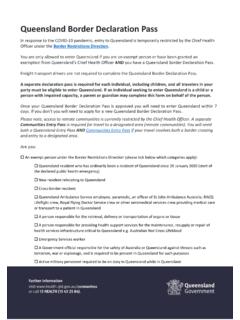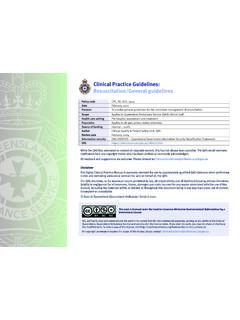Transcription of Occupational Violence Prevention in Queensland Health’s ...
1 Occupational Violence Prevention in Queensland health 's Hospital and health Services Taskforce Report 31 May 2016. Occupational Violence Prevention in Queensland health 's Hospital and health Services Published by the State of Queensland ( Queensland health ), May 2016. This document is licensed under a Creative Commons Attribution Australia licence. To view a copy of this licence, visit State of Queensland ( Queensland health ) 2016. You are free to copy, communicate and adapt the work, as long as you attribute the State of Queensland ( Queensland health ). For more information contact: Department of health , GPO Box 48, Brisbane QLD 4001. An electronic version of this document is available at Disclaimer: The content presented in this publication is distributed by the Queensland Government as an information source only.
2 The State of Queensland makes no statements, representations or warranties about the accuracy, completeness or reliability of any information contained in this publication. The State of Queensland disclaims all responsibility and all liability (including without limitation for liability in negligence) for all expenses, losses, damages and costs you might incur as a result of the information being inaccurate or incomplete in any way, and for any reason reliance was placed on such information. Occupational Violence Prevention in Queensland health 's Hospital and health Services -1- Contents Executive summary .. 4. 1. Recommendations .. 7. 2. Occupational Violence definition and 10.
3 Definition .. 10. Causal 10. The Queensland Public health 11. 3. Establishment of the Taskforce .. 14. 4. Taskforce process (data gathering) .. 15. 5. Occupational Violence : the Queensland health data perspective .. 17. 6. Current policy framework .. 21. 7. Snapshot of current strategies/initiatives in the Hospital and health Services and Queensland Ambulance 23. Hospital and health Services' Occupational Violence self assessment .. 23. Queensland Ambulance Service's Paramedic Safety Taskforce .. 24. Systems and data 25. Case studies of contemporary good practice in Queensland health .. 26. Occupational Violence Strategy: Metro South HHS .. 26. The Safewards' initiative.
4 27. Code Grey': Townsville 28. Prepositioning nurses in the watchhouse Gold Coast University Hospital .. 28. Peer support program: The Park - Centre for Mental health , Wacol .. 29. Police and Ambulance Intervention Plans (PAIP) .. 29. 8. Findings and recommendations .. 30. General 30. Occupational Violence : a Queensland health definition .. 30. Duty of care obligations .. 31. Societal context of Violence .. 32. Organisational culture .. 34. Occupational Violence strategic plans .. 40. Prevention strategies .. 40. Risk assessment and risk management .. 40. Training and capability 43. Work practices .. 46. Workplace design .. 47. Information sharing .. 48. Data analytics.
5 50. Protective interventions .. 51. Occupational Violence as a clinical issue .. 51. Technology .. 53. Security services 54. Seclusion and restraint .. 55. Post-incident management .. 56. Occupational Violence Prevention in Queensland health 's Hospital and health Services -2- Focus on the wellbeing of the victim .. 56. Incident investigations .. 58. 59. The withdrawal of health care .. 61. 9. Model of engagement .. 62. 10. Implementation Issues .. 62. References .. 64. Appendix 1 .. 66. Appendix 2 .. 68. Paramedic Safety Taskforce Final Report April 2016 .. 68. Summary of recommendations .. 70. Appendix 3 .. 72. HHS Occupational Violence Self Assessment Summary .. 72.
6 Key findings .. 72. Appendix 4 .. 78. Occupational Violence Forum 21 March 2016: Breakout sessions .. 78. Background .. 78. Setting the context of Occupational Violence .. 78. Appendix 5 .. 84. Occupational Violence Prevention in Queensland health 's Hospital and health Services -3- Executive summary The Occupational Violence in Hospital and health Services Prevention Taskforce was established by the Director-General, Department of health , Michael Walsh at the request of the Minister of health and Minister of Ambulance Services, Hon. Cameron Dick MP in January 2016 to: evaluate the effectiveness of current Occupational Violence intervention strategies and identify barriers and solutions to be considered review the findings and strategies implemented by other jurisdiction health services following the recent Victorian Occupational Violence against Healthcare Workers report propose an Occupational Violence intervention strategy and implementation plan to support Hospital and health Services (HHSs).
7 Workers in the public health system provide a critical service in caring for the community. Healthcare workers are particularly vulnerable to Occupational Violence because they deal with people in stressful, unpredictable and potentially volatile situations. These situations include patients and mental health consumers whose clinical condition may lead to unintentional violent behaviour, concerned family and friends who may become upset and agitated as a result of the patient's condition, and individuals whose drug or alcohol-fuelled aggression threatens the safety of health professionals. The causal factors of aggression and Violence in health settings are complex and inter- connected.
8 They include medical conditions such as dementia, delirium, mental illness or head trauma. Some individuals have attributes such as a history of substance abuse or difficulty dealing with stressful situations. They may have poor communication skills. It may be frustration caused by the circumstances of their treatments or a reaction to those clinical treatments. Fear and uncertainty created by their condition can trigger aggression. The behaviour or attitude of staff can also be a catalyst for aggression. Hospital policy and procedures may not be understood and/or accepted. Violence in health settings may also be related to broader societal factors in which Violence and other anti-social behaviours are evident.
9 The issue of Occupational Violence in health environments is a serious issue with the potential for tragic outcomes; and one which is impacting on the health workers and paramedics nationally and internationally. The death of Gayle Woodford, a nurse in a remote Indigenous community in South Australia in March 2016 is a chilling reminder of just how tragic the consequences can be. Locally, the incident, in which a number of staff were assaulted at the Royal Brisbane and Women's Hospital on Sunday 15 May 2015, provides a serious and graphic example of the risks to personal safety of health workers. Despite the considerable attention to Occupational Violence in Queensland health since 2001, the incidence and impact of Occupational Violence against health workers remains problematic.
10 Occupational Violence Prevention in Queensland health 's Hospital and health Services -4- Queensland health data from 2010-11 until March 2016 indicates that the number of reported incidents of Occupational Violence has ranged from 4500 (2013-14) to 5900. (2012-13) incidents. In 2014-15, about 3325 of the 5030 reported incidents were from the nursing profession, with nearly 10 per cent of that employment group impacted by aggressive or violent behaviour by patients or consumers. Interestingly, the number of reported incidents in the first three-quarters of 2015-16 has increased significantly. If the trend continues, the projected number of incidents for the 2015-16 year would be around 6700; an increase of over 30 per cent on the previous year.












